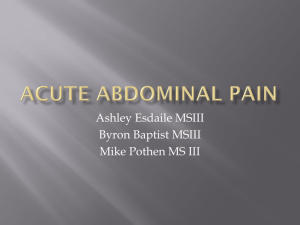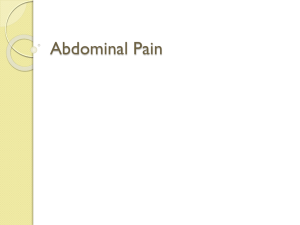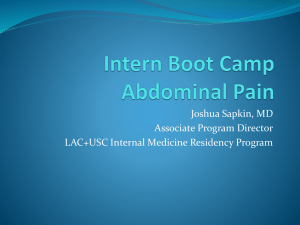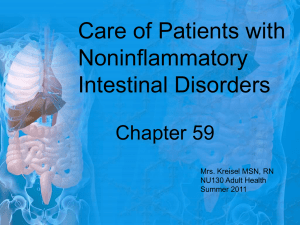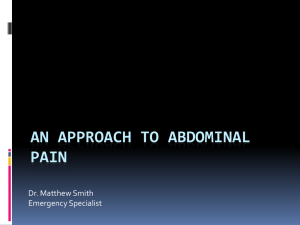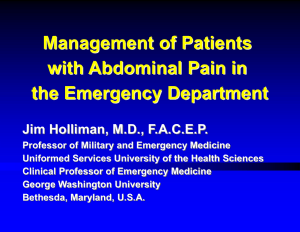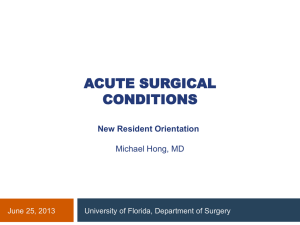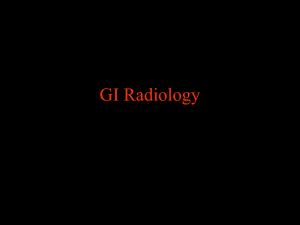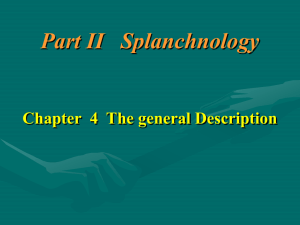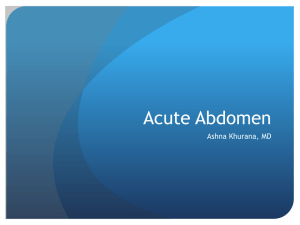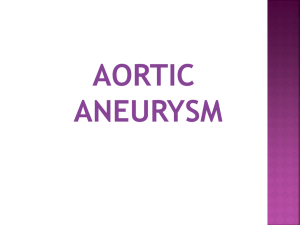Acute Abdominal Pain (2)
advertisement
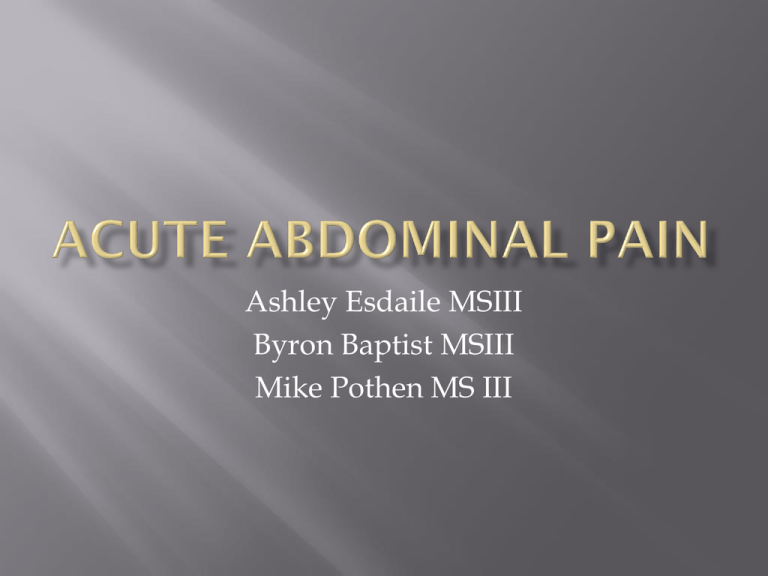
Ashley Esdaile MSIII Byron Baptist MSIII Mike Pothen MS III Acute abdomen Recent or sudden onset of abdominal pain Either new pain, or increase in chronic pain Pain of less than 1 week duration visceral parietal referred Visceral peritoneum Innervated bilaterally by ANS Described as midline, vague, deep, dull, poorly localized Triggered by inflammation, ischemia, geometric changes (ie distension, pressure) Innervated unilaterally via the spinal somatic nerves (also supply abd wall) Pain well localized, sharp, severe Triggered by irritation of parietal peritoneum (ie chemical peritonitis from perforated peptic ulcer or bacterial peritonitis) From deep visceral structure but superficial at presenting site Central neural pathways common to somatic nerves and visceral organs i.e. biliary tract pain – refer to R. inf scapular area; diaphragmatic irritation to ipsilateral shoulder Foregut organs (stomach, duodenum and biliary tract) produce pain in the epigastric region Midgut organs (most small bowel, appendix, cecum) produce periumbilical pain Hindgut organs (most of colon, including sigmoid) and intraperitoneal portions of the genitourinary tract cause pain in the suprapubic or hypogastric area Intraperitoneal visceral pain in felt in the midline because these organs have bilateral innervation 1. Intraabdominal 2. Extraabdominal GI GU GYN Vascular Cardiopulmonary Abdominal wall Toxic-metabolic Neurogenic SUDDEN ONSET OF PAIN (SECONDS) Perforated peptic ulcer - Ruptured abdominal aortic aneurysm - Infarction (MI or acute mesenteric occlusion) - RAPIDLY ACCLERATING PAIN (WITHIN MINUTES) COLIC SYNDROMES Biliary colic, ureteral colic, small bowel obstruction INFLAMMATORY PROCESSES Appendicitis, pancreatitis, diverticulitis ISCHEMIC PROCESSES Mesenteric ischemia, strangulated intestinal obstruction, volvulus GRADUAL ONSET OF PAIN (SEVERAL HOURS) INFLAMMATORY CONDITIONS Appendicitis, cholecystitis OBSTRUCTIVE PROCESSES Nonstrangulated bowel obstruction, urinary retention Case 1 RUQ From usmleworld qbank 2007 Differentials Diagnosis?? - Abdominal aortic aneurysm Acute mesenteric ischemia Amebic hepatic abscesses Appendicitis Biliary colic Biliary disease Cholangiocarcinoma Cholangitis Choledocholithiasis Cholelithiasis GB Cancer GB mucocele Gastric Ulcers - - Gastritis, Acute Gastroesophageal Reflux Disease Hepatitis, Viral Myocardial Infarction Nephrolithiasis Pancreatitis, Acute Peptic Ulcer Disease RLL Pneumonia Pregnancy and Urolithiasis Pyelonephritis, Acute Renal Disease Renal Vein Thrombosis Inflammation of GB commonly caused by gallstone obstruction (90%) Choice B – infection of GB present in 50-70% acute cholecystitis cases secondary to gallstone impaction in cystic duct Patho: Stone obstructs eat fatty food stimulate GB to contract colicky pain stasis bacterial overgrowth inflammation gangrene/ perforation/ peritonitis S/Sx: epigastric or RUQ pain nausea and emesis 4-6 hrs after meal Murphy’s sign May radiate to right scapula Labs: leukocystosis, slight elevation of liver enzymes, increased bilirubin RADIOLOGY: UTZ – shows gallstones, gallbladder thickening, pericholecystic fluid, sonographic Murphy’s sign TREATMENT: Supportive: NPO, IV antibiotics, IV hydration, pain medication Laparoscopic cholecystectomy – consider if perforation or gangrene http://sites.google.com/site/drjoea/calculi-multiple-1e.jpg Ascending Cholangitis Infection of bile ducts secondary to ductal obstruction Life threatening S/Sx: Charcot’s triad: jaundice, fever, RUQ tenderness Reynold’s pentad: add hypotension and mental status change Labs Leukocytosis, increased bilirubin, increased ALP, increased LFTs, blood cultures positive UTZ and CT Biliary duct dilatation from obstructing gallstones Tx Initially supportive: hydration and IV antibiotics If no response: ERCP or PTC for emergency bile duct decompression Most common presentation of symptomatic cholelithiasis S/Sx: constant RUQ pain to epigastric Exception to “colicky pain” which typically waxes and wanes due to hyperpreristalsis of smooth muscle against mechanical site of obstruction UTZ: gallstones but no GB wall thickening or pericholecystic fluid http://emedicine.medscape.com/article/171256-overview Stone in the common bile duct s/sx: RUQ pain worse with fatty meals, juandice UTZ: common bile duct dilatation Labs: increase LFTs, increase bilirubin http://emedicine.medscape.com/article/172216-overview From usmleworld qbank 2007 From usmleworld qbank 2007 Pancreatitis Ruptured Abdominal Aortic Aneurysm Perforated Peptic Ulcer GERD MI Gastroenteritis MCC – alcohol and gallstones S/Sx: severe epigastric pain radiating to patient’s back, N/V, and varying degrees of tachycardia, fever, hypotension (signs of hypovolemia due to “third spacing,” decreased bowel sounds Hemorrhagic pancreatitis Grey turner’s sign – ecchymotic appearing skin findings in flank; Cullen’s sign – skin findings around periumbilical area Labs leukocytosis, increase serum amylase and lipase X-ray: dilated small bowel or transverse colon adjacent to the pancreas called “sentinal loop” CT phlegmon, pseudocyst, necrosis, abscess Tx: IV hydration, NPO, pain control Sudden onset of abdominal pain, radiating to flank, back or both may present as shock (hypotension) Exam findings possible palpable pulsatile abdominal mass Plain Xray – may find calcification in aortic wall; CT scan gold standard (if pt hemodynamically stable) If hypotension + known aneurysm OR Duodenal more common than gastric Ass. w/ chronic NSAID use Sudden onset severe epigastric pain that progresses to peritonitis PE remarkable for diffuse abdominal tenderness, rigidity, and peritoneal signs Plain XR may reveal free intraperitoneal air http://emedicine.medscape.com/article/367878imaging&usg HPI: A 21 year old African American female presents to the ER with the sudden onset of acute abdominal pain. The patient says that the pain began suddenly while she was sitting at home watching television. She localizes the source of the pain to the RLQ and describes it as sharp and continuous with no radiation to any other part of her body. She rates the severity a 10/10 and denies any aggravating or alleviating factors. She says that the pain was so severe it caused her to vomit twice and she currently feels nauseas. She says that she had noticed some crampy abdominal discomfort 2 days prior but attributed it to her getting her period soon. She denies having ever experienced this type of pain in the past. PMHx: Chlamydia 2009, no chronic illness PSHx: None FHx: HTN (both parents), DMII (father), MI (mother) SocHx: She is a college student and lives with a roommate. She is currently sexually active with one male partner and uses condoms occasionally. She has had five sexual partners in her life. She drinks alcohol socially and denies smoking tobacco or doing any drugs. Meds: None Allergies: NKDA Gen: patient feels weak and tired. HEENT: nml CVA: nml Resp: nml GI: she has vomited twice and feels nauseas. GU: nml Genital: G0P0; 11/28/5 regular flow; LMP 4/29/10; uses condoms irregularly, no other form of birth control; Chlamydia ‘09, took doxycycline for 2 days Hematologic: nml Psych: nml Gen: The patient is in extreme pain Vitals: BP 90/63 R 20 P 54 T 97.8 SaO2 98% CVA: S1S2 present, no murmurs heard, bradycardia. Resp: Lungs clear, no wheezing/crackles/rales. Abd: soft and tender in RLQ, guarding present. GU: right adnexal mass palpated, cervical motion tenderness present. Vaginal bleeding present. Ectopic pregnancy Appendicitis Ovarian torsion Salpingitis/tubo-ovarian abscess Endometriosis Yersinia enterocolitis RLQ pain or tenderness at first diffuse then migrates to McBurney’s point Fever Diarrhea PE: rectal exam to check for retroperitoneal appendicitis Labs: high leukocyte count, fecalith present on abd CT or x ray Acute, sharp unilateral abd pain that may be intermittent Pain is related to change in position Nausea Fever Tender adnexal mass Confirm via ultrasound and laparoscopy Constant to crampy or sharp to dull, lower abd pain Purulent vaginal discharge Cervical motion tenderness Adnexal mass Wet mount: WBCs, endocervical culture positive for N. gonorrhoeae or Chlamydia Confirm via ultrasound, CT can rule out appendicitis Gradual or sudden onset of lower abd pain History of dysmenorrhea or cyclic attacks of pain in lower abd More painful with menses Dyspareunia, dyschezia Mild pain: analgesics and referral to OB/GYN Severe pain: hospitalization and possible surgery Severe RLQ pain Fever Diarrhea Difficult to distinguish from appendicitis Labs: fecal culture CBC – WBC 5.2 HGB 10.1 g/dL HCT 33% PLT: 236 Urine pregnancy test -beta hCG 5 459 Transabdominal ultrasound: no products of conception detected in uterine cavity Ruptured ectopic pregnancy Diagnostic laparoscopy Salpingostomy/Salpingectomy Iron therapy for anemia In a stable patient with early ectopic pregnancy can treat with methotrexate 50 mg/m2 intramuscularly as a single dose or multiple doses. Criteria for use: pregnancy < 3.5 cm diameter, unruptured, no fetal heart tones and no active bleeding. 28y/o Caucasian male comes to the ER complaining of left sided abdominal pain. Types of pain presentation Visceral - caused when the nerves on an organ sense an acute stretching of that structure's wall ache poorly localized Parietal/somatic - caused by irritation to the parietal peritoneal wall sharp pinpoint, localized Referred - pain that is felt at a place in the body different from the injured or diseased part where the pain would be expected Skin – trauma, shingles Muscle – trauma, strain Ribs – coastochondritis Aorta – AAA Spleen – injury, tumor Stomach – ulcer, tumor Renal – pylonephritis left kidney, stones, tumor Adrenal - tumor Bowl – inflammation, tumor, crohns, UC, IBS, celiac disease, constipation, infectious process Fallopian tube – ectopic pregnancy, tumor Ovary – abscess, cyst Type of pain is achy and cramping. It began 4 days ago and has not let up. The pain varies in intensity from 6 to 8/10. The Patient states multiple previous episodes for 11 years with severe instances, such as this, causing hospitalization. Patient has diarrhea with blood, and has 9 to 10 bowel movements per day. Patient also complains of pressure in his eyes, fever, weight loss, fatigue, and ulcers in his mouth. Skin – trauma, shingles Muscle – trauma, strain Ribs – coastochondritis Aorta – AAA Spleen – injury, tumor Stomach – ulcer, tumor Renal – pylonephritis left kidney, stones, tumor Adrenal - tumor Bowl – inflammation, tumor, crohns, UC, IBS, celiac disease, constipation, infectious process Fallopian tube – ectopic pregnancy, tumor Ovary – abscess, cyst Crohns Ulcerative colitis IBS Toxic megacolin Celiac disease Colon cancer Crohns - is an inflammatory disease of the intestines that may affect any part of the gastrointestinal tract from mouth to anus, causing a wide variety of symptoms. It primarily causes abdominal pain, diarrhea (which may be bloody), vomiting, or weight loss, but may also cause complications outside of the gastrointestinal tract such as skin rashes, arthritis, inflammation of the eye, tiredness, and lack of concentration. Ulcerative Colitis (UC) – is a relatively common disease that causes inflammation of the large intestine. The cause is unknown. The rectum is always involved. When the inflammation is limited to the rectum, it is called ulcerative proctitis. The inflammation may extend to varying degrees into the upper parts of the colon. When the entire colon is involved, the terms pancolitis or universal colitis are used. Intermittent rectal bleeding, crampy abdominal pain and diarrhea can be symptoms of ulcerative colitis. Ulcerative colitis characteristically waxes and wanes. Many patients experience long remissions, even without medication. Crohns UC Terminal Ileum Common Seldom Colon involvement Usually Always Anus Common Seldom Bile duct No change in rate PSC Higher rate PSC Distribution Skip lesion continuous Depth Transmural Mucosal Fistulae Common Seldom Stenosis Common Seldom Surgical cure Usually returns Usually curative Smoking Higher risk Lower risk IBS - is a diagnosis of exclusion. It is a functional bowel disorder characterized by chronic abdominal pain, discomfort, bloating, and alteration of bowel habits in the absence of any detectable organic cause. In some cases, the symptoms are relieved by bowel movements. Diarrhea or constipation may predominate, or they may alternate (classified as IBS-D, IBS-C or IBS-A, respectively). IBS may begin after an infection (post-infectious, IBSPI), a stressful life event, or onset of maturity without any other medical indicators. Toxic megacolon is a life-threatening complication of other intestinal conditions. It is characterized by a very dilated colon (megacolon), accompanied by bloating, and sometimes fever, abdominal pain, or shock. Celiac Disease - is an autoimmune disorder of the small intestine that occurs in genetically predisposed people of all ages from middle infancy onward. Symptoms include chronic diarrhea, failure to thrive (in children), and fatigue. Upon exposure to gliadin, and certain other prolamins, the enzyme tissue transglutaminase modifies the protein, and the immune system cross-reacts with the small-bowel tissue, causing an inflammatory reaction. That leads to villous atrophy which results in the interference of absorption of nutrients Colon Cancer – includes cancerous growths in the colon, rectum and appendix. Signs and symptoms can be broken down into local (reduction in stool diameter, blood in stool), constitutional (iron deficiency anemia may occur; this may be experienced as fatigue, palpitations and noticed as pallor, weight loss), and metastatic (most commonly spreads to liver which could present with jaundice, biliary obstruction, pale stools). H/o UC H/o apthus ulcers H/o erythema nodosum H/o DVT and PE Surgical hx – tissue biopsy 1999 no complication Family hx – no pertinent history Social hx – works in retail, lives alone, Tobacco – 1 pack/day ETOH – no Drugs – no Allergies- NKDA Medications – Sulfasalizine, dexamethasone Redness in the eyes CVS – tachycardia Abdomen – distended, general tenderness, negative for bowl sounds BP 100/70 T 101.4 P 90 RR 20 sO2 98% rm air ESR - elevated C-reactive protein – elevated WBC – 15k HGB – 10 HCT – 34% Plt – 470k Na - 138 K - 2.9 Cl – 100 CO2 – 24 BUN – 40 Creatinine – 1 Gluc - 100 Tx - objective of treatment is to decompress the bowel and to prevent swallowed air from further distending the bowel Complications Fluid and electrolyte replacement to help prevent dehydration, and shock Corticosteroids for inflammatory reaction Antibiotics to prevent sepsis If decompression is not achieved and patient does not improve within 24 hours, a colectomy is indicated Sepsis Shock Perforation of the colon Prognosis - If the condition does not improve, there is a significant risk of death. In case of poor response to conservative therapy a colectomy is usually required. This may involve all or part of the colon being removed, with the resulting option of anastomosis or colostomy. Emergency action may be required if severe abdominal pain develops, particularly if it is accompanied by fever, rapid heart rate, tenderness when the abdomen is pressed, bloody diarrhea, frequent diarrhea, or painful bowel movements. Tx for Iritis – prednisalone 1-2 gtts q1-8hrs A 61 y/o woman comes to her dr. office for steadily increasing abd girth and fatigue with mild exertion. She has noticed this symptom for the past few months. She reports a 5kg increase in her weight without making any change in her regular diet. Her PMH is unremarkable, although she has not seen a physician for many years. She denies smoking, but admits drinking a glass of wine with meals on weekends. On physical exam, she is afebrile and normotensive. Examination of her abd reveals shifting dullness and a fluid wave, with clear distension. A bedside ultrasound is performed, which demonstrates a large amount of ascitic fluid. Which of the following conditions is the most likely cause of this patient’s current condition? A. Alcohol cirrhosis B. Budd-chiari syndrome C. peritoneal carcinomatosis D. portal vein thrombosis E. Right heart failure A 61 y/o woman comes to her dr. office for steadily increasing abd girth and fatigue with mild exertion. She has noticed this symptom for the past few months. She reports a 5kg increase in her weight without making any change in her regular diet. Her PMH is unremarkable, although she has not seen a physician for many years. She denies smoking, but admits drinking a glass of wine with meals on weekends. On physical exam, she is afebrile and normotensive. Examination of her abd reveals shifting dullness and a fluid wave, with clear distension. A bedside ultrasound is performed, which demonstrates a large amount of ascitic fluid. Which of the following conditions is the most likely cause of this patient’s current condition? A. Alcohol cirrhosis B. Budd-chiari syndrome C. peritoneal carcinomatosis D. portal vein thrombosis E. Right heart failure Pt. has late ovarian cancer. There are no indications for liver insufficiency, or cardiac insufficiency. A 24 y/o white women comes to the physician complaining of 6 months of crampy abd pain. The pain has been localized to the RLQ, and is made worse by eating. She has also noted an increase in the number of her bowel movements to approximately four per day, and the stools have become semi-formed. She denies any fevers, chills, or night sweats during this period. She has lost 15 lbs from her baseline weight of 128 lb over the past 6 months. She has also noted aching in her knees, and ankles during this interval. On physical examination, she is slightly pale and has two oral ulcers on the inner lower lip that are covered by a gray exudate and surrounded by an erythematous halo. The abd is soft but tender in the right lower quadrant. No masses are palpable and there is no hepatosplenomegaly. Rectal exam reveals brown stool, which is guaiac-positive. Which of the following diagnostic test would be the most accurate for this patient? A. Abd CT scan B. abd sonogram scan C. barium enema D. colonoscopy E. sigmoidoscopy F. upper GI series A 24 y/o white women comes to the physician complaining of 6 months of crampy abd pain. The pain has been localized to the RLQ, and is made worse by eating. She has also noted an increase in the number of her bowel movements to approximately four per day, and the stools have become semi-formed. She denies any fevers, chills, or night sweats during this period. She has lost 15 lbs from her baseline weight of 128 lb over the past 6 months. She has also noted aching in her knees, and ankles during this interval. On physical examination, she is slightly pale and has two oral ulcers on the inner lower lip that are covered by a gray exudate and surrounded by an erythematous halo. The abd is soft but tender in the right lower quadrant. No masses are palpable and there is no hepatosplenomegaly. Rectal exam reveals brown stool, which is guaiac-positive. Which of the following diagnostic test would be the most accurate for this patient? A. Abd CT scan B. abd sonogram scan C. barium enema D. colonoscopy E. sigmoidoscopy F. upper GI series Pt has Crohns, and colonoscopy with entry into the terminal ileum is the main way of diagnosing ileocolonic disease, as described in this patient. Ayala Carlos, Spellberg Brad, “Chapter 2. Surgery”. Boards and Wards, 4e. Wolters Kluwer, Lippincott Williams & Wilkins, 2010. Gallagher E. J, "Chapter 72. Acute Abdominal Pain" (Chapter). Tintinalli JE, Kelen GD, Stapczynski JS, Ma OJ, Cline DM: Tintinalli's Emergency Medicine: A Comprehensive Study Guide, 6e: http://www.accessmedicine.com/content.aspx?aID=592077. Krause Richard S, Janicke David M, "Chapter 103. Ectopic Pregnancy" (Chapter). Tintinalli JE, Kelen GD, Stapczynski JS, Ma OJ, Cline DM: Tintinalli's Emergency Medicine: A Comprehensive Study Guide, 6e: http://www.accessmedicine.com/content.aspx?aID=594594. Platt Melissa, Doshi Samir, Telfer Eric, "Chapter 13. Abdominal Pain" (Chapter). Stone CK, Humphries RL: CURRENT Diagnosis & Treatment: Emergency Medicine, 6e: http://www.accessmedicine.com/content.aspx?aID=3099123. Klingensmith, Mary, Chen Li Ern, Glasgow Sean, Goers Trudie, Melby Spencer. “Chapter 11, The Washington Manual of Surgery.” Wolters Kluwer, Lippincott Williams & Wilkins, 2008. Usmleworld qbank 2007
